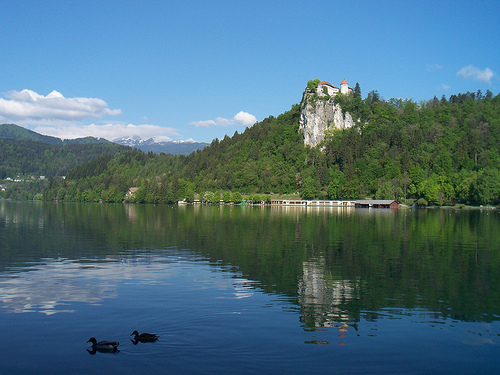

Location: Bled, Upper Carniola Map
Open: Apr- Oct 8am- 8pm
Nov- March: 8am- 6pm
Entrance Fee: adult €7
Children €6
Bled Castle that is also known as castellum Veldes is a medieval citadel situated in Bled, Upper Carniola region of North- west Slovenia. Bled Castle was constructed in the 10th century on a 130 meters high cliff overlooking lake Bled. It is one of the oldest castles in the country and also one of the most visited destinations. Renaissance tower is the oldest part of the stronghold with later additions that were added over time. It served as a royal residence until 1011 when Emperor Henry II presented it to the Albuin Bishop of Brixen. In 1278 it passed to the Austrian branch of House of Habsburg. The castle was protected by a moat and a drawbridge. The chapel was added in the 17th century and later reconstructed in the 18th century. It is covered by frescoes that are in a fairly good condition. It is open to the public all year round. It contains a small museum devoted to the history of the Bled Castle.
Lake Bled below was formed in the end of Ice Age when Bohinj glacier retreated leaving behind this beautiful lake. It reaches a depth of 31 meters with dimensions of 2120 meters by 1380 meters. Additionally Bled is a popular starting point for exploration of theTriglav National Park.
Bled entered the historical period in 1004 with the charter of the
German Emperor Henry II. who donated the Bled estate to the Diocese
of Brixen , Bishop Albuin. In 1011, Henry II. donated to the
successor of Bishop Albiun, Bishop Adalberon, Bled Castle, and for
30 royal farms of land. In this grant, the castle of Bled (
castellum Veldes ) is mentioned for the first time. According to the
time of mention, it is among the oldest in the sources called
castles in Slovenia . The Bishops of Brixen rarely came to Bled, so
the estates were initially managed and guarded by the Bishop's
ministers , until 1349 the knights of Bled. In the mid- 14th
centurythe bishops abandoned the direct administration of the
lordship and leased it to the then manager Konrad von Kreigh as a
loan guarantee. The Kreigh family reigned in Bled for almost 200
years (1368–1558). Due to the deprivation of farmers' rights and the
mistreatment of the peasants , the peasants of Bled also joined the
pan-Slovenian rebellion in 1515 . For Kreighi and their relatives
Turni, in 1558, the renowned Turkish war hero Baron Herbard
Auersperg ( Turkish) took over the lease .
Because he was a great protector of Protestantism , which at that
time spread to Bled, in 1574 he had to leave Bled and lease it to a
follower of the Catholic party, Baron Ivan Joseph Lenkovich . He
died in 1680, and his estate was managed by Count Žiga Turn
(1592–1597). From 1597 to 1615, the bishops renounced their
leasehold status and appointed chiefs themselves . After 1615 Bled
was leased by Prince John of Eggenberg (until 1634), Adam Pipian
(1634-1642), Karel Weidmann (1642-1651), Engelbert Wolf Auersperg
(1651-1666), John Petschacher (1666-1669), Wilhelm Baltasar von
Loewenfeldt (1669-1674), again Petschacher (1674-1677), a relative
of Barons Gallenfels (1677–1721 and 1731–1744), including Anton
Ignatius von Loewenegg, John Toman (1744–1750), Baron Indermauer
(1751–1769), Franz Florian Chrobath (1769–1774), Joseph Stefancich
(1774–1782), Ignac Novak (1782–1804). The chiefs were nobles until
the mid- 18th century , later replaced by the townspeople.
After 800 years of Brixen rule, in 1803 the Bled domination was
nationalized by order of the Vienna Court of Commission. During the
Illyrian Provinces (1809-1813), domination was the property of the
French state , and the income was enjoyed by the Governor-General,
Marshal Auguste Marmont . In 1838, all nationalized property was
returned to the diocese of Brixen. In 1858, the Bishop and Capitol
sold the Bled estate and the island's property for 150,000 goldinars
to the burgher entrepreneur Viktor Ruard , owner of the Jesenice
ironworks. Ruard sold extensive forests in 1871 to the Carniolan
Industrial Company, he kept the castle, lake and construction land
around the lake. In 1882 the estate came into the hands of the
wholesaler Adolf Muhr, and in 1918 the castle with the lake and the
island was bought by the hotelier Ivan Kenda . The castle was taken
over by the Cooperative Commercial Bank in 1937 and then by Dravska
Banovina . It is now owned by the state. It is managed by the
Cultural Institute of Bled . The castle was hit by two earthquakes ,
in 1511 , after which it was rebuilt by Herbard Auersperg, and in
1690, when it was repaired by the Gallenfels. His Gothic
fortification system remained preserved .